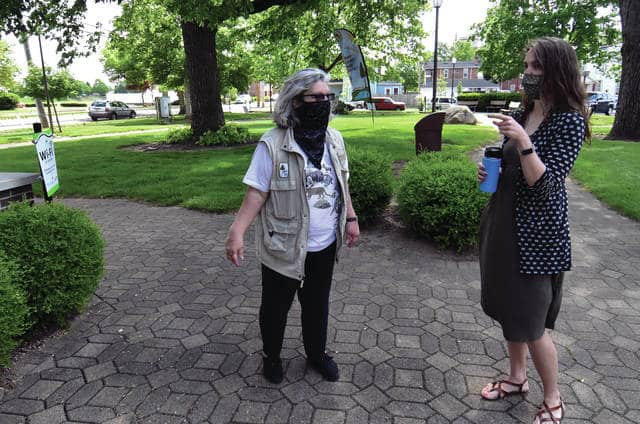
Miami County Park District Naturalist Tonia Molla chats with Miami County Public Library Children’s Program Coordinator Chrysalis Cantrell at Brukner Park behind the Troy/Miami County Public Library on Saturday during the “Cecily Cicada,” Storybook Trail Program.
Mike Ullery | Miami Valley Today
By Melody Vallieu
MIAMI COUNTY — The Miami County Park District has partnered with an author to help residents learn more about the loud, red-eyed insects that will soon emerge from the ground.
In order to help people understand the 17-year cicadas, and maybe relieve some of the worries of their presence soon to come, the park district created a storybook trail of “Cecily Cicada,” a book by Kita Murdock. Murdock wrote and illustrated the book with her mother, Patsy Helmetag, to help change how people perceive insects, specifically the cicadas.
The storybook trail is a professionally made project that displays each page of the book in poster size that is weather-resistant and portable, according to Miami County Park District Educational Naturalist Marj Gaskell.
The park district is offering the storybook trails throughout May at parks and libraries throughout Miami County, Gaskell said.
Gaskell said while they don’t have any entomologists on staff, park district staff has created a packet for teachers and students that includes interesting information they have discovered and activities students can do to continue their learning.
“We expect the Periodical Cicada to emerge once the temperature underground is 64 degrees,” said Gaskell, who said that could be as early as this week. “We noticed the cicada turrets at Charleston Falls two to three weeks ago, so we know they are coming. When you lift the turret, you can see the tunnel the cicada created, and sometimes you can see the cicada. The tunnels they create are beneficial to our lawns and trees as they aerate the soil.”
Gaskell said the cicadas will emerge in large numbers.
“That appears to be their only defense as they don’t bite or sting. They are not poisonous or venomous. Lots of animals will feast on the cicadas, but they will not be able to eat them all,” Gaskell said. “That allows the Periodical cicada to survive. Many will survive to create the next generation.”
Gaskell said after emerging from the ground, they will climb up the nearest tree, leaving their hard exoskeleton on the tree’s trunk. The adult will be white in color but will darken and harden quickly. The adult Periodical cicada has a black body (head, thorax, abdomen) and red eyes, she said.
“The males will sing in chorus to the females to attract a mate,” said Gaskell, who said many will remember the 17-year cicada because of its loud singing. “People have used a decibel meter to find that some can be as loud as a rock concert. The males make the sound using organs called tymbals on the sides of their bodies. The females respond by clicking their wings.”
After the cicadas mate, the female will make a slit in a tender branch of a tree to lay her eggs, Gaskell said. After a few weeks, the nymphs will crawl out from the twig, fall from the tree, then burrow underground, Gaskell said. They will find a tree root from which to sip the fluids over the next 17 years as they slowly develop through the nymph stages, she said, which does not harm the tree.
The adult cicadas live for three to six weeks mating and laying eggs.
“Then they die. Their dead bodies become food for the decomposers. Their decomposed bodies will nourish the soil and plants.
“Everything has a purpose,” Gaskell said.


